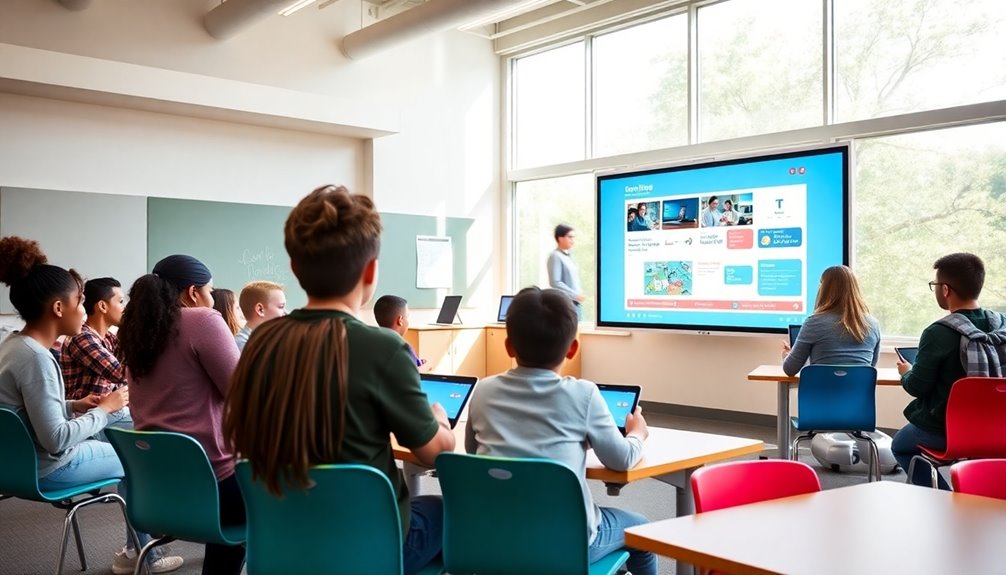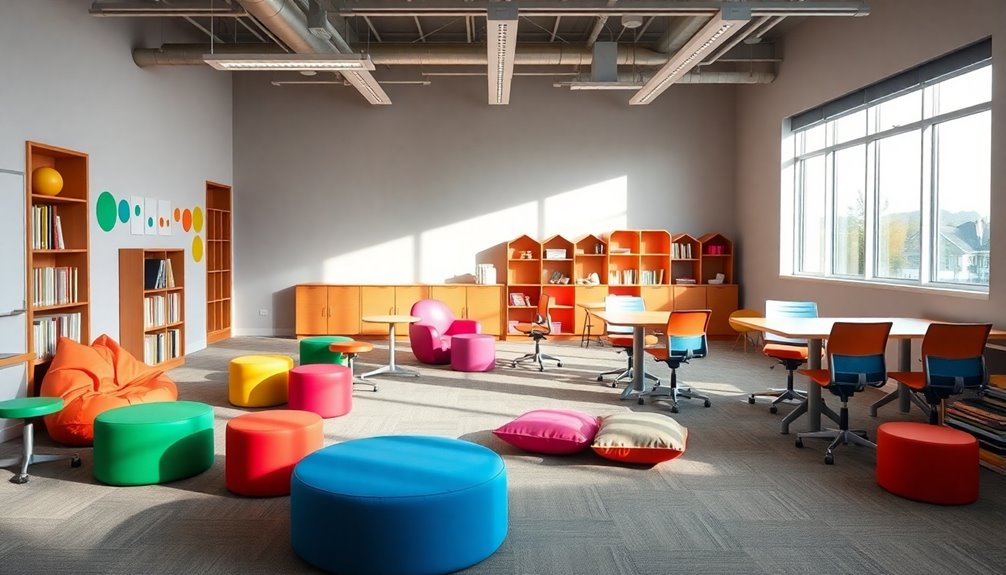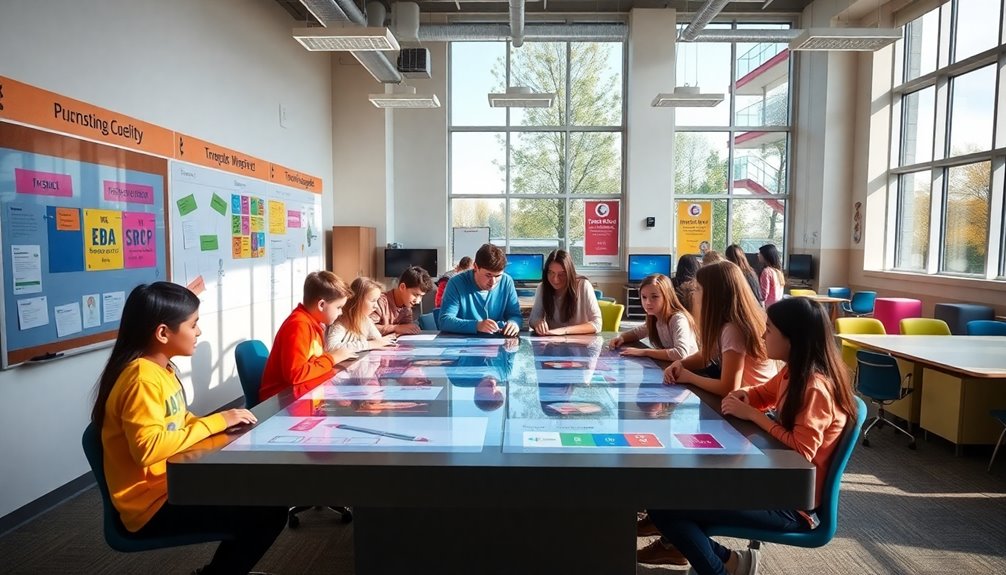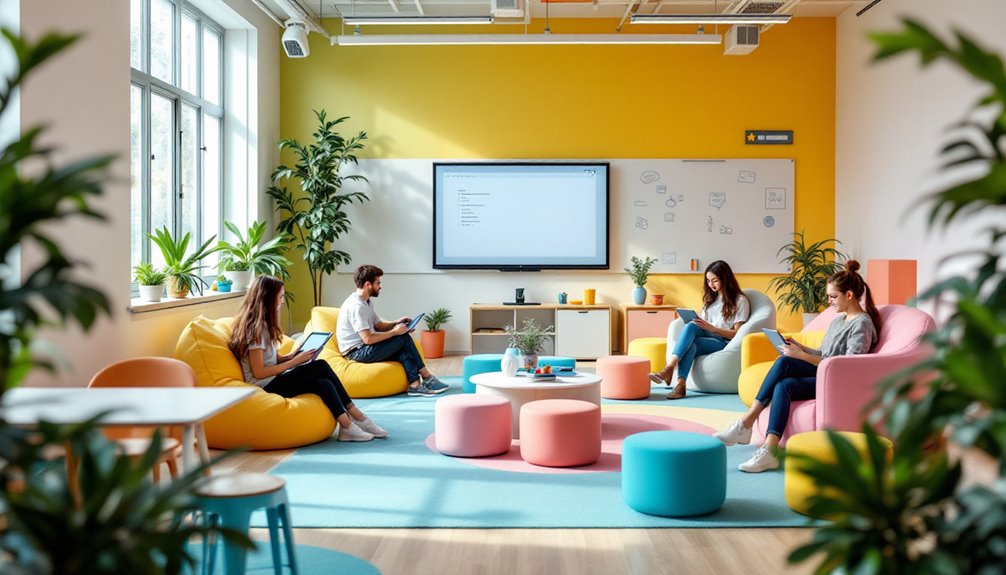To modernize your classroom, integrate interactive technology like gamified learning and utilize digital assessment tools for real-time feedback. Foster collaboration with diverse seating options and collaborative learning spaces. Implement project-based learning for real-world problem-solving and leverage online learning platforms for flexibility. Incorporate virtual reality and multisensory tools to create engaging experiences. Promote student-centered learning to empower students. There's much more to discover about creating a dynamic classroom environment.
Highlights
- Integrate interactive technology to create immersive and engaging learning experiences.
- Foster collaborative learning spaces that enhance teamwork and creativity.
- Implement flexible seating arrangements to accommodate diverse learning styles.
- Utilize digital assessment tools for streamlined grading and instant feedback.
- Encourage project-based learning to promote active engagement and real-world application.
Integrate Interactive Technology

In today's digital age, integrating interactive technology into the classroom isn't just beneficial—it's essential. You're at the forefront of transforming traditional teaching methods into dynamic learning experiences.
Imagine enchanting your students with interactive presentations that bring subjects to life, making learning far more engaging. It's not just about delivering information; it's about creating an immersive environment where students actively participate.
Embrace gamified learning to tap into the competitive spirit of students, encouraging them to learn through play. Gamification can turn even the most complex topics into fun challenges, with points, badges, and leaderboards motivating students to push their limits and achieve more. Additionally, leveraging advanced analytics can provide insights into learner behavior, enabling educators to further enhance engagement strategies.
Foster Collaborative Learning Spaces
While interactive technology transforms the learning process, it's equally important to cultivate spaces that encourage collaboration among students. By fostering an environment that supports group activities, you empower students to engage dynamically with their peers.
Encourage students to work together, solving problems collaboratively and sharing unique perspectives. This not only builds teamwork skills but also sparks creativity and innovation.
Fostering collaboration enhances teamwork and ignites creativity and innovation among students.
To maximize collaboration, establish areas where students can comfortably gather for discussions and projects. Facilitate peer feedback sessions, allowing students to learn from each other and refine their ideas.
This approach nurtures a culture of openness and critical thinking. By prioritizing collaborative spaces, you're equipping students with the skills they need to thrive in today's interconnected world, making the classroom a hub of innovation. Additionally, implementing data-driven strategies can further enhance collaborative learning by providing insights into student engagement and performance.
Implement Flexible Seating Arrangements

Implementing flexible seating arrangements can vastly enhance student engagement and comfort.
It's all about giving students the freedom to choose where they learn best. Imagine transforming your classroom into a dynamic space where student choice reigns supreme. With options like bean bags, standing desks, or cozy nooks, you're creating comfort zones that cater to diverse learning styles.
This approach doesn't just modernize your classroom; it empowers students to take ownership of their learning environment. As students find their unique comfort zones, they're more likely to engage, collaborate, and thrive. Additionally, incorporating expert teachers from creative industries into your curriculum can inspire students and broaden their perspectives on learning.
Utilize Digital Assessment Tools
You're probably looking for ways to make grading more efficient, and digital assessment tools can help you streamline the process. Not only do these tools save you time, but they also enhance student engagement by providing interactive and immediate feedback. Additionally, incorporating automation and data-driven decision-making can further improve your assessment processes and outcomes.
Streamline Grading Process
To enhance efficiency in managing classroom tasks, integrating digital assessment tools can revolutionize the grading process. Grading software offers an innovative approach to evaluating student work, saving you time and reducing errors.
This technology enables you to streamline your workflow and focus on what truly matters—student learning. Embrace these modern tools to simplify grading:
- Automated Feedback: Provide instant feedback to students, creating a dynamic learning environment that fosters growth and understanding.
- Peer Assessment: Encourage students to assess each other's work using digital platforms, promoting collaborative learning and critical thinking.
- Analytics: Gain insights into student performance trends, allowing for data-driven decisions to enhance teaching strategies.
Enhance Student Engagement
Engaging students in the learning process can be greatly enhanced by incorporating digital assessment tools into your teaching strategy. These innovative tools tap directly into student interests, making learning more interactive and personalized.
By using platforms that offer real-time quizzes and polls, you can create dynamic feedback loops that keep students actively involved. They can instantly see their progress, allowing you to adjust lessons on the fly based on their understanding.
Digital assessments also cater to various learning styles, ensuring that every student finds a way to connect with the material. Plus, they provide you with valuable data to identify trends and tailor your approach.
Embrace these tools to foster a forward-thinking classroom where engagement isn't just a goal, but a reality.
Encourage Project-Based Learning

Project-based learning transforms the traditional classroom into a dynamic environment where students actively engage with the material.
By incorporating real world applications and interdisciplinary projects, you can spark curiosity and innovation. Here's how you can effectively implement it:
- Real-World Problems: Encourage students to tackle real-world issues, helping them see the relevance of their studies and fostering critical thinking skills.
- Interdisciplinary Projects: Combine subjects to create thorough projects that require students to apply knowledge from various fields, promoting a holistic understanding.
- Collaborative Learning: Foster teamwork by assigning group projects that require collaboration, communication, and collective problem-solving.
Additionally, leveraging data-driven decision making can help educators refine their project-based approaches for enhanced student engagement and learning outcomes.
Enhance Communication Channels
When communication channels are enhanced in the classroom, it opens up opportunities for more effective learning and interaction. By integrating advanced communication tools, you can foster an environment where students feel empowered to express ideas and collaborate effortlessly. Effective feedback becomes instantaneous, allowing students to adjust and improve rapidly. Additionally, leveraging automation solutions can streamline communication processes, making it easier for educators to manage interactions and feedback.
Consider these tools to elevate communication:
| Communication Tool | Benefit |
|---|---|
| Digital Forums | Encourages open discussion |
| Instant Messaging Apps | Promotes quick communication |
| Video Conferencing | Facilitates remote learning |
| Collaborative Platforms | Enhances group projects |
Incorporate Virtual Reality Experiences
Many believe virtual reality (VR) is transforming the classroom experience by immersing students in diverse learning environments.
Embrace this innovation to spark curiosity and deepen understanding. Imagine taking your class on virtual field trips to explore ancient ruins or the depths of the ocean, all from the comfort of your classroom.
VR offers students experiences they'd otherwise never have.
Unlock unparalleled experiences for students with VR, venturing beyond traditional learning boundaries.
Here are three ways to incorporate VR into your teaching:
- Virtual Field Trips: Transport students to historical sites or distant planets, enhancing lessons with firsthand exploration.
- Immersive Storytelling: Engage students with stories that place them at the heart of the narrative, fostering empathy and connection.
- Skill Development: Use VR simulations to practice real-world skills in a risk-free environment, preparing students for future challenges. Additionally, leveraging data-driven decision-making can further enhance the effectiveness of VR in education by tailoring experiences to students' unique learning needs.
Develop a Multisensory Environment
While virtual reality opens up a world of possibilities, it's just one piece of creating an engaging classroom. To truly innovate, consider developing a multisensory environment that stimulates all of your students' senses.
Start by integrating sensory stations—dedicated areas that offer diverse experiences. These stations can include tactile materials like textured fabrics, kinetic sand, or interactive wall panels. Such materials not only engage touch but also enhance cognitive and emotional development.
Incorporate auditory elements, like nature sounds or calming music, to create a soothing atmosphere. Visual stimuli, such as dynamic lighting or colorful displays, can also capture students' attention. Additionally, implementing automation of operational workflows can help streamline the management of these sensory stations, allowing for more effective engagement.
Promote Student-Centered Learning
To truly engage students and foster a deeper understanding, it's vital to promote student-centered learning in your classroom. By focusing on student autonomy and personalized learning, you'll cultivate an environment where innovation thrives.
Promote student-centered learning to cultivate an innovative and engaging classroom environment.
Here are three dynamic strategies to reflect on:
- Empower Decision-Making: Encourage students to make choices in their learning paths. This boosts engagement and ownership of their education journey.
- Differentiate Instruction: Tailor lessons to meet diverse learning styles and needs. Personalized learning guarantees each student progresses at their own pace while mastering essential skills.
- Facilitate Collaborative Projects: Foster teamwork and problem-solving through group activities. This not only enhances critical thinking but also prepares students for real-world scenarios.
Implement these strategies to create a forward-thinking classroom that inspires and excites. Additionally, leveraging data-driven approaches can further enhance student engagement and optimize learning outcomes.
Leverage Online Learning Platforms
When integrated effectively, online learning platforms can transform your classroom into a dynamic and interactive space. By embracing online course integration, you're opening the door to a world of possibilities that keep your students engaged and enthusiastic to learn.
Imagine a classroom where digital resource sharing is seamless, allowing students instant access to materials at any time. This not only fosters a more flexible learning environment but also encourages independent exploration and collaboration.
To modernize your teaching approach, consider platforms that offer interactive modules, virtual discussions, and real-time feedback. These tools empower students to take charge of their own learning journey. Additionally, integrating technology-driven execution can enhance your classroom's operational efficiency and support more effective teaching methods.
Some Questions Answered
How Can I Manage Classroom Distractions With New Technology?
You can manage classroom distractions with new technology by integrating focus techniques. Utilize distraction tools like noise-canceling headphones or apps that block irrelevant content. Encourage students to embrace these innovations for a more productive learning environment.
What Budget Considerations Should I Keep in Mind for Modernization?
When considering budget for modernization, prioritize cost-effective solutions and explore diverse funding sources. Don't overlook grants or community partnerships. Innovation doesn't always mean expensive; it's about smart investments that enhance learning without straining your financial resources.
Are There Age-Specific Strategies for Classroom Modernization?
When modernizing classrooms, tailor strategies to each age group, ensuring they're developmentally appropriate. Use technology and flexible spaces to boost student engagement. Innovate with interactive tools, fostering creativity and collaboration for a dynamic learning environment that excites students.
How Can I Ensure Technology Use Is Equitable for All Students?
You're tackling the digital divide like a superhero! Guarantee access equity by providing devices, Wi-Fi hotspots, and tech support for all students. It's essential for leveling the playing field and releasing their boundless potential for innovation.
What Are the Best Practices for Training Teachers in New Classroom Technologies?
For training teachers in new classroom technologies, prioritize professional development sessions that focus on seamless technology integration. Encourage hands-on workshops, peer collaboration, and ongoing support. Emphasize adaptability and creativity to inspire innovative teaching methods that engage students.
Summing Everything Up
To truly modernize your classroom, remember that 77% of educators believe technology increases student engagement. By integrating interactive tech and fostering collaborative spaces, you're not just updating your environment; you're creating a dynamic learning experience. Embrace flexible seating, digital tools, and project-based learning to cater to diverse needs. Virtual reality and multisensory environments can transform lessons, while student-centered approaches and online platforms guarantee every student thrives. You're paving the way for future-ready learners.





